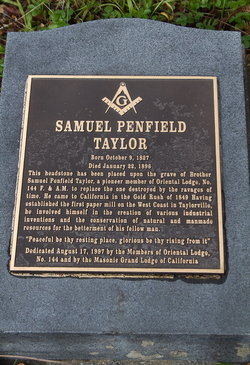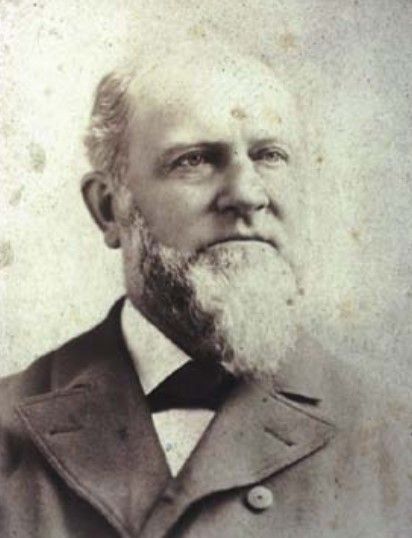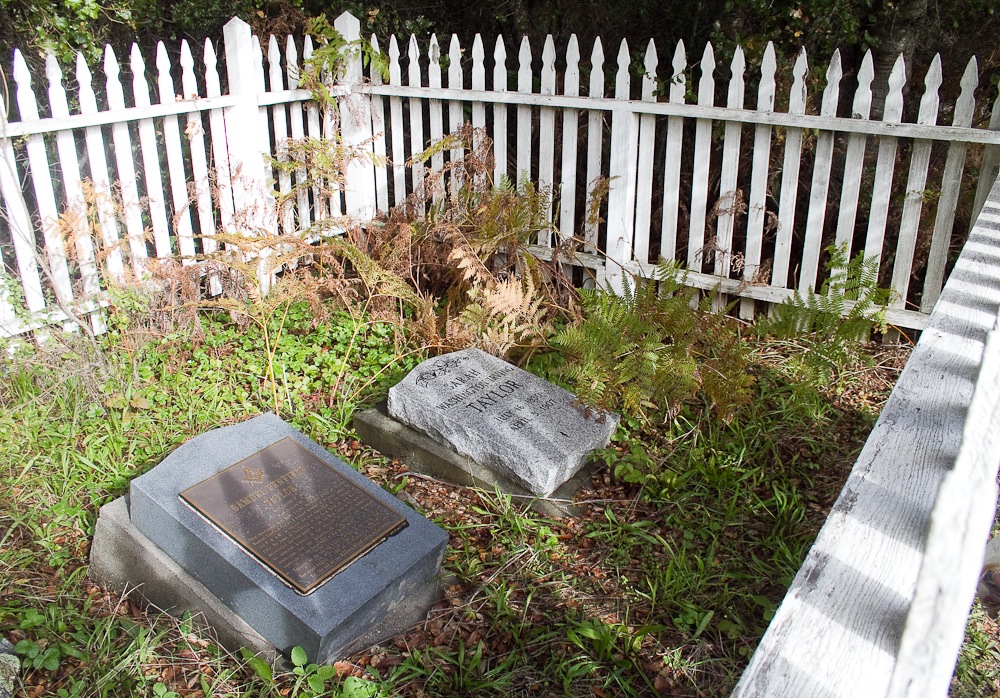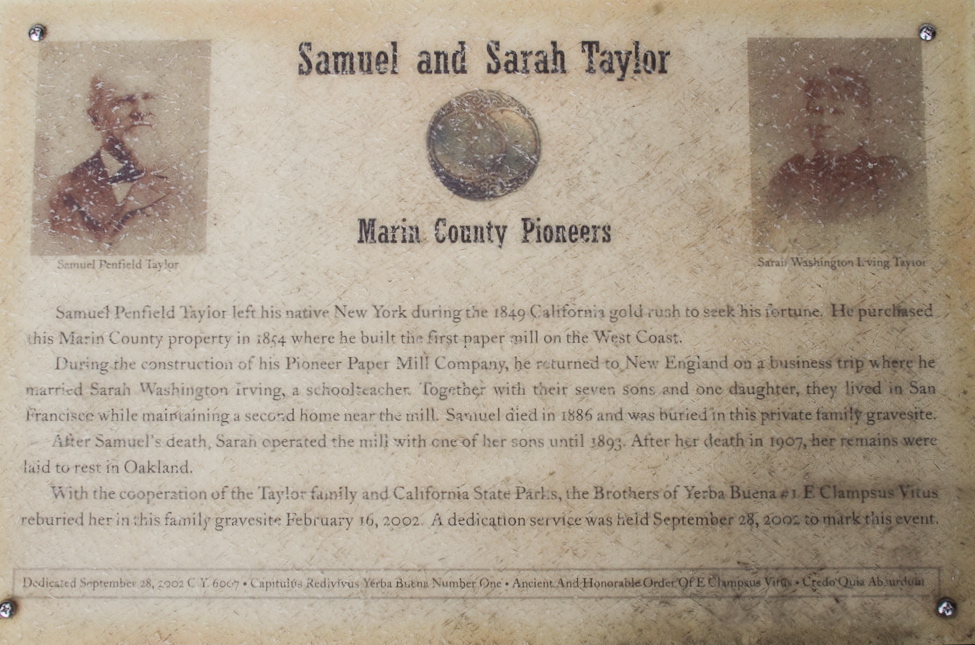Founder of Taylorville
San Francisco Board of Supervisors
Member #87 of Oriental Lodge No. 144
In 1848, at the age of 21, Samuel P. Taylor caught the "gold fever" then sweeping the East Coast. He joined with friends to purchase a schooner and left Boston Harbor in early 1849. After a ten-month voyage that contained many stops along the way for repairs, the ship and crew arrived in San Francisco Bay. The crew and passengers left the next day for the gold country, leaving Taylor to sell the ship.
An entrepreneur at heart he saw that there was money in cooking and selling meals. He went into the bacon and egg business and sold hot meals from a plank stand on the beach in front of his ship along the San Francisco waterfront.
He made enough money from this enterprise to go into the lumber business with his future brother-in-law Isaac Cook. His lumberyard was located at the corner of California Street near Drumm Street.
Taking some time off in 1853, he went to Hawkins' Bar in Tuolumne County and made $5,691.99 in gold, working the streams in the Sierra foothills. Using this profit, he expanded his lumber interests. While looking for trees for his lumberyard, Samuel Taylor rode into Western Marin County. As he explored the area for wood to harvest, he came to a stop west of present day Lagunitas. He decided this spot would make an excellent location for a paper mill. The mill site deeply impressed him as it had an abundance of fresh water and raw materials to make the mill a success. He purchased 100 acres of land from the local landowner for $505.00. Samuel Taylor's father owned a paper mill back in New York on the Hudson River. It must have been this experience that enabled him to envision a successful business in this wilderness spot.
Samuel Taylor was a man of vision, and looking at this site in the wilderness of western Marin county with no roads or trails, miles from the ocean and the bay, this was to become his home, an industrial complex, a farm center and a recreational paradise.
In 1854-55 he returned to Fall River, Massachusetts in search of industrial goods to start his paper mill. He met and married Sarah Washington Irving, who gave up her position as a school teacher in Fall River and returned to San Francisco with Samuel Taylor and shared with him the creation of his dream to build the first paper mill west of the Allegheny's.
They called the paper mill, the Pioneer Paper Mill Company as it was indeed the first paper mill built in the western United States. To run his mill he needed water to turn his mill wheel (steam engines had yet to reach California). The mill however was in an isolated part of western Marin County, far away from the busy San Francisco Bay. In order to get raw materials into the mill and paper out to the City he had to construct roads and purchase a schooner to take paper and supplies to and from San Francisco.
It was said that if Taylor's schooner was late in arriving from Marin, the daily edition of San Francisco newspapers could not be printed. With his spirit of determination Samuel Taylor started to build his life, his family and his fortune around his Paper Mill on that little creek in western Marin County.
In time, he had enough people living around his mill that it became known as Taylorville. Some were involved in running the paper mill, others in hauling the goods in and out along the new roads by ox carts. Still others tended to the many dairy cows that Samuel Taylor imported from New Jersey. As the mill grew and steam power was introduced, cord wood was needed to keep the steam engines going twenty-four hours a day. At one point, Taylor had a black powder mill, a fur tannery, a tanbark mill and the Azalea Hotel as part of industries running on his property. Supporting industry; grocery, laundry, saloon, dance hall, riding stable, butcher shop.
When the North Pacific Coast Railroad pushed through to Western Marin, Taylorville was an important stop. Samuel Taylor had been a major backer of this new road of steel in Marin County. He built the Azalea Hotel in Taylorville for visitors to stop and spend a few days away from the "City". Camp Taylor Resort was one of the largest recreational "tented cities" in America and was popular for its camping and picnics. He allowed people from the bay area cities to come and camp during the summer months, swim in his big pond, fish and hunt. The famous Bohemian Club of San Francisco held its first "JINKS" outdoor at Taylorville in 1878.
Between 1855 and 1893, the Pioneer Paper Mill expanded and grew. Samuel Taylor's paper products were well known everywhere on the West Coast. The mill produced a vast line of products. The "flat-bottomed bag" was invented and perfected into what we know today as the common paper bag. The mill perfected green and red-striped candy bags, hat bags, ballot and book paper and manila wrapping. Samuel Taylor's exhibits at the state fair were perennial prize winners.
As his paper mill grew, Samuel Taylor became involved in several environmental projects far ahead of his time. In order to produce quality paper, he collected rags and old paper, recycling them at his mill into new paper products. His employees collected rags and old paper from San Francisco and other cities in the state. Also, in order to help the salmon and steel-head around his mill pond dam on Paper Mill Creek, he created the first fish ladder on the West Coast. Imagine the impact on the salmon population if he did not seek to preserve them so many years ago. It is rumored that he also introduced oyster farming to western Marin County.
While involved in all these commercial enterprises, he found time to raise a large family and serve as a member of the San Francisco Board of Supervisors. In his earlier days he was a member of the famous Vigilantes Committee. He took his civic duties seriously and helped build schools, improve streets and create a better city.
Mrs. Sarah Taylor worked with other women of the city to assist in stopping the smuggling of Chinese slave girls into San Francisco and helped start the Chinatown Presbyterian Mission. In one five year period she boarded every ship coming in from the Far East, arranging with the ships captains to release the girls into her care and took them to the Mission where they were protected.
It was said that every Tuesday night you could find Samuel P. Taylor within the halls of Oriental Lodge No. 144, San Francisco taking part in the business of Masonry. The records from the early years of the lodge were destroyed in the devastation of the Great Quake of 1906. From the letters and speeches that did survive, it appears that Samuel P. Taylor was held in high regard by his Masonry brethren.
Samuel Penfield Taylor died in his home in San Francisco at the age of 58. The members of Oriental Lodge held a Masonic Funeral for him within their Lodge Room located at the Masonic Hall on Post and Montgomery Streets. His body was then taken across the Bay by ferry, then train and was carried up the brow of a hill across from his paper mill and buried in what was designated as the Taylor family plot in Taylorville. This beloved business and civic leader, who had become a living example of a just and upright man to so many others who were fortunate enough to be called his friends, had passed on to his heavenly reward. With heavy hearts, and saddened beyond words his family and friends, along with all those who had worked for him all those long years slowly climbed the steep hill and laid their friend to rest.
Today there is no paper mill on Paper Mill Creek. It burned down in 1916. Taylorville is gone and so are the railroad, and the dam and all the supporting enterprises such as the hotel, bowling alley, saloons, and riding stable. Instead you will find, Samuel P. Taylor State Park, approximately 2700 acres of redwood groves and grassland. The foundations of his paper mill are still visible along the trails and remnants of his fish ladder lie in the creek.
The Taylor grave-site is on a knoll in the shadow of Mount Barnabe. Mount Barnabe was named by Taylor in honor of his retired white army mule. It is rumored that Barnabe, Taylor's favorite pet, is buried near him.
bio by Colletta
(see Sarah for list of their children)
Death Notice
TAYLOR. In Taylorville, Marin county, January 22, Samuel Penfield Taylor, a native of Sangerties, N.Y., aged 58 years.
Published Marin Journal
January 28, 1886
Founder of Taylorville
San Francisco Board of Supervisors
Member #87 of Oriental Lodge No. 144
In 1848, at the age of 21, Samuel P. Taylor caught the "gold fever" then sweeping the East Coast. He joined with friends to purchase a schooner and left Boston Harbor in early 1849. After a ten-month voyage that contained many stops along the way for repairs, the ship and crew arrived in San Francisco Bay. The crew and passengers left the next day for the gold country, leaving Taylor to sell the ship.
An entrepreneur at heart he saw that there was money in cooking and selling meals. He went into the bacon and egg business and sold hot meals from a plank stand on the beach in front of his ship along the San Francisco waterfront.
He made enough money from this enterprise to go into the lumber business with his future brother-in-law Isaac Cook. His lumberyard was located at the corner of California Street near Drumm Street.
Taking some time off in 1853, he went to Hawkins' Bar in Tuolumne County and made $5,691.99 in gold, working the streams in the Sierra foothills. Using this profit, he expanded his lumber interests. While looking for trees for his lumberyard, Samuel Taylor rode into Western Marin County. As he explored the area for wood to harvest, he came to a stop west of present day Lagunitas. He decided this spot would make an excellent location for a paper mill. The mill site deeply impressed him as it had an abundance of fresh water and raw materials to make the mill a success. He purchased 100 acres of land from the local landowner for $505.00. Samuel Taylor's father owned a paper mill back in New York on the Hudson River. It must have been this experience that enabled him to envision a successful business in this wilderness spot.
Samuel Taylor was a man of vision, and looking at this site in the wilderness of western Marin county with no roads or trails, miles from the ocean and the bay, this was to become his home, an industrial complex, a farm center and a recreational paradise.
In 1854-55 he returned to Fall River, Massachusetts in search of industrial goods to start his paper mill. He met and married Sarah Washington Irving, who gave up her position as a school teacher in Fall River and returned to San Francisco with Samuel Taylor and shared with him the creation of his dream to build the first paper mill west of the Allegheny's.
They called the paper mill, the Pioneer Paper Mill Company as it was indeed the first paper mill built in the western United States. To run his mill he needed water to turn his mill wheel (steam engines had yet to reach California). The mill however was in an isolated part of western Marin County, far away from the busy San Francisco Bay. In order to get raw materials into the mill and paper out to the City he had to construct roads and purchase a schooner to take paper and supplies to and from San Francisco.
It was said that if Taylor's schooner was late in arriving from Marin, the daily edition of San Francisco newspapers could not be printed. With his spirit of determination Samuel Taylor started to build his life, his family and his fortune around his Paper Mill on that little creek in western Marin County.
In time, he had enough people living around his mill that it became known as Taylorville. Some were involved in running the paper mill, others in hauling the goods in and out along the new roads by ox carts. Still others tended to the many dairy cows that Samuel Taylor imported from New Jersey. As the mill grew and steam power was introduced, cord wood was needed to keep the steam engines going twenty-four hours a day. At one point, Taylor had a black powder mill, a fur tannery, a tanbark mill and the Azalea Hotel as part of industries running on his property. Supporting industry; grocery, laundry, saloon, dance hall, riding stable, butcher shop.
When the North Pacific Coast Railroad pushed through to Western Marin, Taylorville was an important stop. Samuel Taylor had been a major backer of this new road of steel in Marin County. He built the Azalea Hotel in Taylorville for visitors to stop and spend a few days away from the "City". Camp Taylor Resort was one of the largest recreational "tented cities" in America and was popular for its camping and picnics. He allowed people from the bay area cities to come and camp during the summer months, swim in his big pond, fish and hunt. The famous Bohemian Club of San Francisco held its first "JINKS" outdoor at Taylorville in 1878.
Between 1855 and 1893, the Pioneer Paper Mill expanded and grew. Samuel Taylor's paper products were well known everywhere on the West Coast. The mill produced a vast line of products. The "flat-bottomed bag" was invented and perfected into what we know today as the common paper bag. The mill perfected green and red-striped candy bags, hat bags, ballot and book paper and manila wrapping. Samuel Taylor's exhibits at the state fair were perennial prize winners.
As his paper mill grew, Samuel Taylor became involved in several environmental projects far ahead of his time. In order to produce quality paper, he collected rags and old paper, recycling them at his mill into new paper products. His employees collected rags and old paper from San Francisco and other cities in the state. Also, in order to help the salmon and steel-head around his mill pond dam on Paper Mill Creek, he created the first fish ladder on the West Coast. Imagine the impact on the salmon population if he did not seek to preserve them so many years ago. It is rumored that he also introduced oyster farming to western Marin County.
While involved in all these commercial enterprises, he found time to raise a large family and serve as a member of the San Francisco Board of Supervisors. In his earlier days he was a member of the famous Vigilantes Committee. He took his civic duties seriously and helped build schools, improve streets and create a better city.
Mrs. Sarah Taylor worked with other women of the city to assist in stopping the smuggling of Chinese slave girls into San Francisco and helped start the Chinatown Presbyterian Mission. In one five year period she boarded every ship coming in from the Far East, arranging with the ships captains to release the girls into her care and took them to the Mission where they were protected.
It was said that every Tuesday night you could find Samuel P. Taylor within the halls of Oriental Lodge No. 144, San Francisco taking part in the business of Masonry. The records from the early years of the lodge were destroyed in the devastation of the Great Quake of 1906. From the letters and speeches that did survive, it appears that Samuel P. Taylor was held in high regard by his Masonry brethren.
Samuel Penfield Taylor died in his home in San Francisco at the age of 58. The members of Oriental Lodge held a Masonic Funeral for him within their Lodge Room located at the Masonic Hall on Post and Montgomery Streets. His body was then taken across the Bay by ferry, then train and was carried up the brow of a hill across from his paper mill and buried in what was designated as the Taylor family plot in Taylorville. This beloved business and civic leader, who had become a living example of a just and upright man to so many others who were fortunate enough to be called his friends, had passed on to his heavenly reward. With heavy hearts, and saddened beyond words his family and friends, along with all those who had worked for him all those long years slowly climbed the steep hill and laid their friend to rest.
Today there is no paper mill on Paper Mill Creek. It burned down in 1916. Taylorville is gone and so are the railroad, and the dam and all the supporting enterprises such as the hotel, bowling alley, saloons, and riding stable. Instead you will find, Samuel P. Taylor State Park, approximately 2700 acres of redwood groves and grassland. The foundations of his paper mill are still visible along the trails and remnants of his fish ladder lie in the creek.
The Taylor grave-site is on a knoll in the shadow of Mount Barnabe. Mount Barnabe was named by Taylor in honor of his retired white army mule. It is rumored that Barnabe, Taylor's favorite pet, is buried near him.
bio by Colletta
(see Sarah for list of their children)
Death Notice
TAYLOR. In Taylorville, Marin county, January 22, Samuel Penfield Taylor, a native of Sangerties, N.Y., aged 58 years.
Published Marin Journal
January 28, 1886
Inscription
"Peaceful by thy resting place, glorious by thy rising from it"
Family Members
Advertisement
Advertisement











